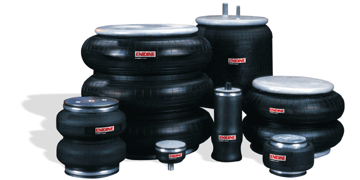By studying Enidine air springs, their architecture and hallmark design features, the investigator in charge of this study can’t help but admire the product range’s component-less force storage capabilities. A flexing natural rubber or fabric-toughened neoprene core delivers vibration isolating strength to the pneumatic dampeners. They even perform as actuators, with their interior flex members replacing conventional air cylinders. Back to the investigator, though, exactly how do the springs work?
Enidine Air Springs Dampen Vibrations
It’s as simple as that, they’re designed to absorb and store kinetic energy. If vibrations are propagating noisily through a metal frame, the installation of an air spring acts as an impact governor. It smoothens those noisy shakes and shudders so that an equipment frame doesn’t shake itself apart. As for its interior functions, let’s use a single convolute bellows model to illustrate the design principles. That single “convolute” device arrives as a lone doughnut-shaped ring, which is locked between a series of fastening plates. For our purposes, the YI-1B5-502 is chosen from its selection chart. It’s fitted to a scissor-lift, a lifting bench that’s a key segment in a manufacturing line’s process chain. Here, the elastically imbued rubber absorbs the scissoring frame’s vibratory clicks-and-clacks as it rises and falls. Locking itself at a set height, those vibratory energies then dissipate.
How Do Air Springs Work?
Simple but elegant energy-dampening laws rule the device’s interior architecture. There’s a quantity of compressible air sealed inside the rubberised housing of a high-performance Enidine air spring. As a load exerts its noisy presence, that air is distributed, then the rubber bladder follows suit. This process continues until the stretching rubber, compressed air and shrinking space equalise against the vibratory force. Granted, an air cylinder operates in a similar manner, but that cylindrical device can’t alter its shape to accommodate the spreading air. By substituting a rubberised member, the air can distribute freely inside that elastic housing. Thanks to this design, a double convolute YI-2B6-530, using its twin-ring build, can isolate industrial-strength machine oscillations. If that doubled-up dampener architecture isn’t up to the job, there’s the option to upgrade once again, this time to a triple convolute type air spring.
Indeed, tripled-up or smaller, Enidine air springs just work. On looking at those rubber/neoprene flex members, they don’t assume their duties unless they’re sandwiched between their forged or cast retainer caps. By the way, those end plates are made of heavy steel or aluminium, or there’s a cast zinc option. They compress their air-filled elastic bellows while performing as variable or intermittent load distribution plates. Then, with the air springs active, the expanding and compressing rubber pushes against those plates to provide stroke height control and that all-important vibration-isolating feature.
For more information, download the air springs catalogue, visit our Enidine page or contact us.


